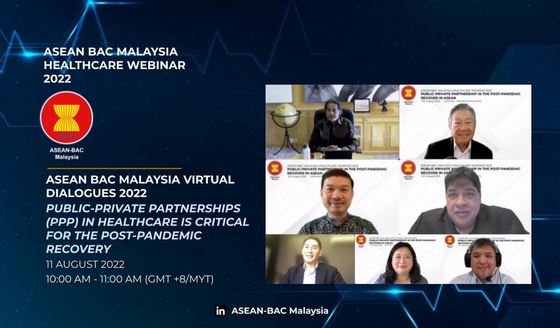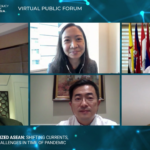Kuala Lumpur, 11 August 2022 — The ASEAN Business Advisory Council Malaysia webinar on “Public-Private Health Partnerships in ASEAN’s Post-COVID Recovery” was held to discuss the importance and trajectory of ASEAN’s healthcare policies, promote effective initiatives and policies implementation both domestically and regionally.
The webinar featured a keynote address by Yang Berhormat (YB) Khairy Jamaluddin, Minister of Health of Malaysia (MOH). Dr Khor Swee Kheng, Chair of ASEAN-BAC Healthcare Working Group (HWG) who moderated the panel session, with expert input from Dr Eduardo Banzon, Principal Health Specialist, Southeast Asia Regional Department of Asian Development Bank (Philippines), Dr Eugene Hong, Executive Director, Head Pharmaceuticals and Healthcare of DBS Bank (Singapore) and Dr Lei Hsien-Hsien, Chief Executive Officer of American Chamber of Commerce (AmCham) Singapore.
Council Member of ASEAN-BAC Malaysia Tan Sri Yong Poh Kon in his opening remarks, mentioned that the healthcare market in Southeast Asia was worth USD 420 billion with the private sector making up 53% of the market. Due to the economic slowdown, governments find their revenues diminished and face increasing pressures to find avenues for tax collection, which reduces the capacity of the government to deliver healthcare services in the country. “Therefore, there is a very strong role for the private sector to support the public sector, in delivering healthcare to its citizens” according to Tan Sri Yong.
PPPs have proven to be successful during the pandemic and will continue to grow as a digital healthcare landscape
YB Khairy Jamaluddin in his keynote speech emphasised the importance of accelerating Malaysia’s recovery from the effects of the pandemic. Public-private partnership (PPP) is crucial in boosting the economy and propelling the health sector’s development during these difficult times. The collaboration utilises this unique opportunity for innovation and improvement in the health sector and other industries, ensuring better public services and value for the taxpayer.
YB Khairy also identified the opportunities that the public and private sectors can focus on in Malaysia and ASEAN level with the view that some of the challenges that we face in Malaysia apply to other ASEAN countries as well.
This includes (i) the unification of Malaysia’s digital health platform in terms of electronic medical records by utilising digital tools, (ii) optimising public-private resources to maximise delivery of healthcare services, (iii) reducing secondary and tertiary healthcare costs by promoting preventative healthcare and improving primary healthcare, (iv) working with pharmaceutical and private hospitals in for the cost and access to affordable drugs, as well as (v) promoting Malaysia and ASEAN as a clinical research hub.
The COVID pandemic has shown the PPP is beneficial, resulting in an accelerated process and response to the pandemic.
Dr Lei believed that the most successful PPPs have accelerated processes and responses during the pandemic. “We would never have imagined that we could so quickly bring together public sector hospitals providers together with private hospitals, to increase the capacity of hospital beds”, said Dr Lei.
Despite the sensitivity of pricing discussions, Dr Lei commented that compromises were made for the “greater good” to ensure that emergency supplies are accessible and directed to “where they should go” during the pandemic, resulting in “the successful PPP between the Singapore government and 3M Healthcare”.
“Ministry of Health also collaborated with eight thousand private general practitioners around the country to deliver vaccines to the population during the pandemic, which resulted in Malaysia achieving the fastest per capita per day vaccination rate in the world,” said YB Khairy.
Framework for successful future PPPs needs to be consistent despite the changes in governments
PPPs are complex, requiring changes in the political economy, smart regulations and private sector capacity-building, commented Dr Khor. Dr Hong added that “you will need to have people within the government and within the ministry, that can design the contracts and to be able to understand what are the endpoints” to make PPPs work. Dr Banzon concurred with Dr Hong’s point but added that stability of the contract, despite changes in government will also ensure continuity in the PPP arrangements. According to Dr Lei, there is a further need for checks and balances to understand how to mitigate risk, and how to optimise efficiency and affected effectiveness for a successful PPP.
PPP also resulted in innovation and technology advances in the healthcare sector, catalysing the growth of digital healthcare in the region.
According to YB Khairy, lifetime health records can be carried in a health app and can be shared with consent. This is an opportunity where the MoH of Malaysia wants to ensure the inclusiveness of the private sector in investing in the future.
The minister shared that the PPP solution lies in identifying the collaborative processes and negotiating a fair price with the private sector, done transparently and ensuring that it is predictable and that it does not change unreasonably. YB further stresses that “one of the biggest revelations of this pandemic was the need to build a future-proof healthcare system”.
The pandemic enhanced and accelerated the digitalisation of healthcare, and ASEAN will probably start seeing a lot more technology being used for at-home monitoring of patients instead of in the hospitals, said Dr Hong. During the pandemic, private healthcare providers were brought on board to support the public healthcare system, and when Southeast Asia moves towards a more universal healthcare system, we will see more PPPs.
“Malaysia is working towards tabling the Healthcare White Paper (HWP) to strengthen the nation’s healthcare system as an equitable and high-quality system providing accessible, affordable and sustainable healthcare. In line with the “whole of government” and “whole of society” approach, this document will incorporate recommendations and outcomes from multiple studies in the healthcare system as well as the views and positions of the federal and state government ministries or agencies and health sector stakeholders including the private sector and the community,” said YB Khairy.
In closing, Tan Sri Yong noted that the webinar highlighted some commonalities among the ASEAN countries relating to issues of government contracts on PPPs and the importance of digital tools; either for a lifetime, health records, or for monitoring at home.








